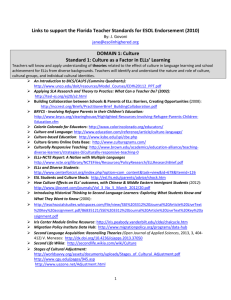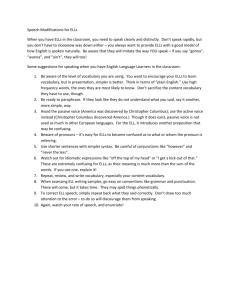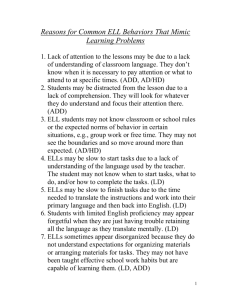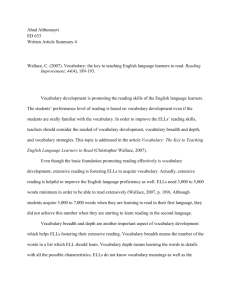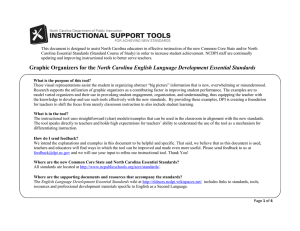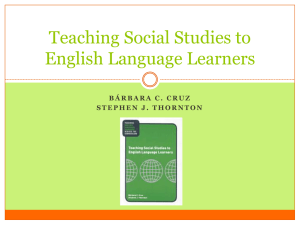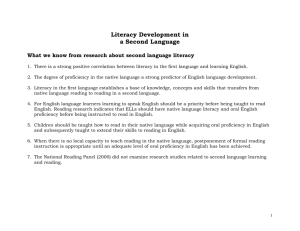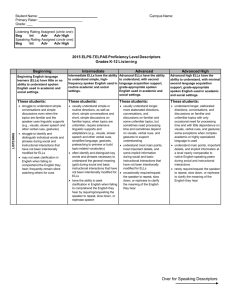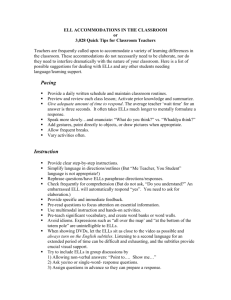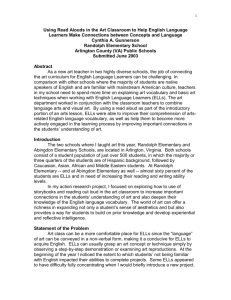Overarching Language Objective - WIDA 2015 National Conference
advertisement
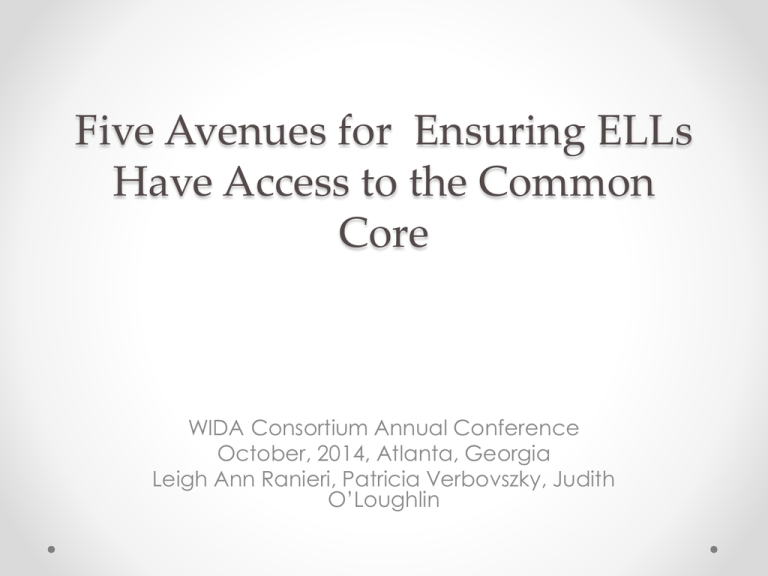
Five Avenues for Ensuring ELLs Have Access to the Common Core WIDA Consortium Annual Conference October, 2014, Atlanta, Georgia Leigh Ann Ranieri, Patricia Verbovszky, Judith O’Loughlin Agenda • • • • • • Introduce Presenters Objectives Give one/Get one/Move on (Go/Go/Mo) Rationale/Can Do Descriptor Key Avenues Questions Objectives • Participants will leave with at least two strategies that they can immediately implement. • Participants will be able to discuss the modeled strategies with a partner in a small group. • Participants will be able to complete at least one graphic organizer with a partner or in a small group. Presenters • Dr. Leigh Ann Ranieri, Director of Pupil Services, West Chester Area School District • Patricia Verbovszky, Supervisor of ELL and Assessment, West Chester Area School District • Judith B. O’Loughlin, Educational Consultant, Language Matters Education Consultants, LLC Go/Go/Mo • Give one/Get one/Move on • Record three ideas about how to provide ELLs access to the curriculum based on the Common Core. • Stand up. • Exchange ideas with at least two other people. • Move on • Continue to exchange ideas until the timer sounds. • Report out. Transition • • • • • Purpose for test scores Professional development Results Expectations Accountability Curriculum Based on the Common Core • • • • • • All students must have access. Professional Learning Communities Collaboration ELLs belong to all faculty and staff Shared responsibility High stakes test scores Five Avenues for Successful Access 1. Language Objectives 2. Visuals 3. Processing Time 4. Practice Time 5. Teacher Collaboration Time In order for students to successfully access the curriculum, they will need to have all five avenues in place. Who are ELLs? • Vignettes • Activity Can Do Descriptors • What can ELLs do at different ELP levels? • Activity: Compare students in the vignettes with the different descriptors • Activity: Matrix • Activity: Expectations Language Objectives Tools for Writing Language Objectives Cognitive Function Word Context for Language Use Language Domain Topic Related Language ELL Developmental Level Sentence Frame Overarching Language Objective: Students will be able to orally apply (or demonstrate) their knowledge of the impact of weather conditions after investigating and collecting weather data from different locations (communities, regions, and nations). Objectives for Students at Different ELD Levels Student-Friendly Language • We can show maps, charts, and graphs and name weather conditions and what happens to people in different types of weather. • Now it’s Your Turn. • Work with a partner. • Write a student-friendly language objective. • Choose a Level: Levels 2, 3, or 4. • Choose a Language Domain or Integrated Domain (e.g. Listen/Read or Speak/Write) • Share Visuals Strategy Format Define the strategy. Model and demonstrate how strategy works. Connect the strategy to the core/district standards Provide opportunity for participants to apply strategy and practice it. • Provide appropriate English language proficiency level. • • • • Reading Strategy for Literature • Picture the Main Idea • CC.4.R.L.2: Determine the theme of a story, drama, or poem from details in the text; summarize the text. o Students benefit from supportive frameworks and step-by-step strategies to identify essential story meaning and details. Visuals Picture the Main Idea Packet Activity Picture the Main Idea Model Picture the Main Idea Model Picture the Main Idea Model: Supporting Detail Chart Main Idea Supporting Details Picture the Main Idea • Guided Practice Up North at the Cabin by Marsha Wilson Chall Picture the Main Idea Text: Up North at the Cabin Main Idea Supporting Details Picture the Main Idea Guided Practice: Read Passage Complete supporting detail chart Main Idea Supporting Details Picture the Main Idea Independent Practice Owl Moon by Jane Yolen Picture the Main Idea Independent: Read Passage Complete Supporting Detail Chart Main Idea Supporting Details Processing Time Processing Time Processing time Think-pair-share Think-write-pair-share Turn and talk: What are some other processing time strategies that will work in your buildings? • Feedback • What are the benefits for ELLs? • • • • Practice Time Practice Time • • • • Practice time Incorporate it during the day. Time in school may be only time available for ELLs Partner Practice Time • Turn and Talk: o How can educators incorporate more practice time within the context of the school day? Teacher Collaboration Time Teacher Collaboration Time • Department Meetings • Professional Learning Communities • Common Planning Time Questions Ticket-out-the-Door • Please complete a Ticket-out-the-Door and leave it with us. • Thank you. References • Dove, M. G., & Honigsfeld, A. (2013). Common core for the not-so-common learner:English language arts strategies grades K-5. Thousand Oaks, PA: Corwin Press. • Echevarria, J. J., Vogt, M., & Short, D. (2012). Making content comprehensible for English language learners: The SIOP model (4th ed.). N.p.: Pearson. • Kinsella, Kate (in general—her body of work) • www.cast.org (universal design for learning) • West Ed (in general—body of work) • www.wida.us

